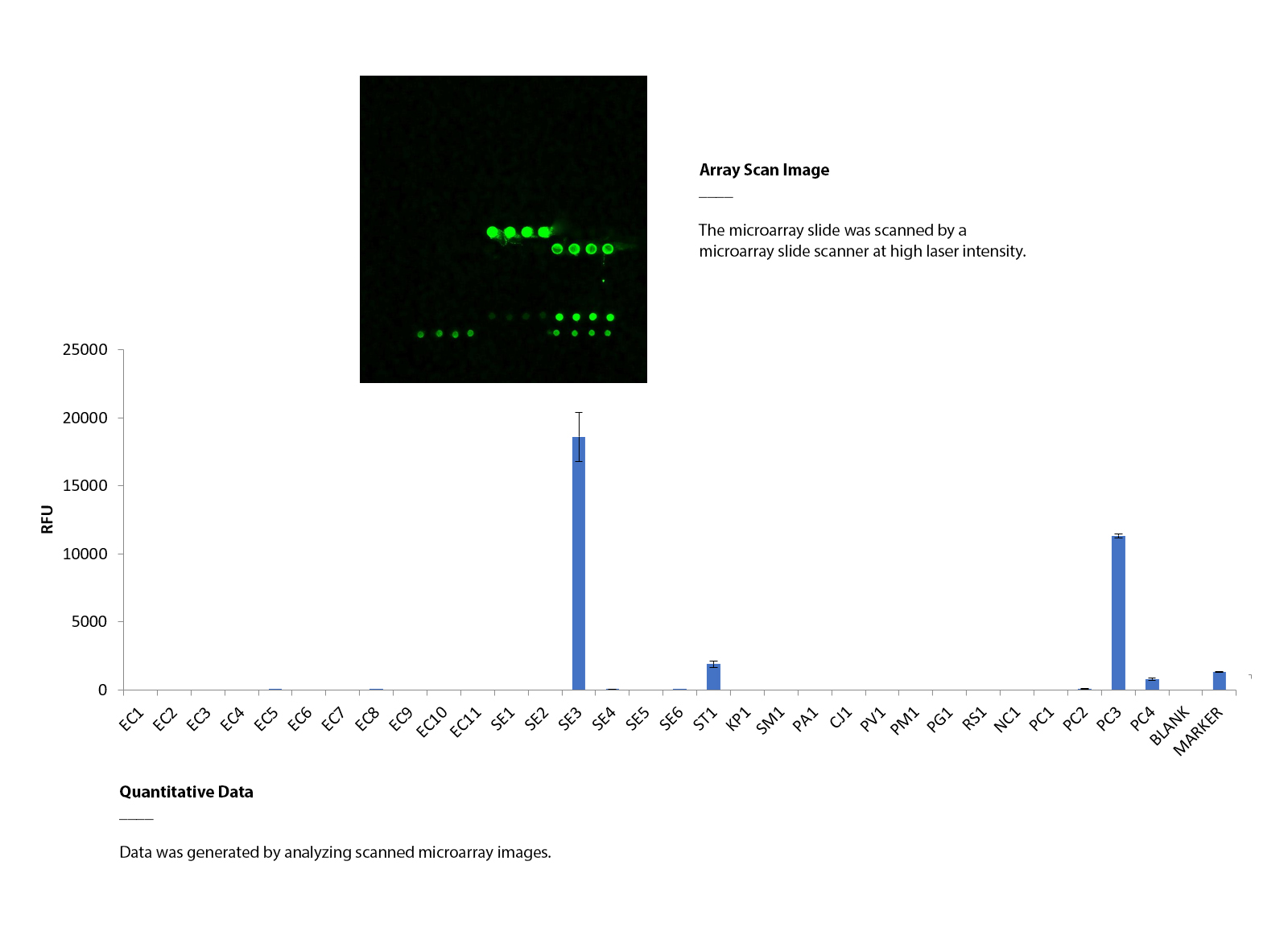

From: $864.00
Bacterial glycan microarray allows researchers to explore the interactions between bacterial O-antigens and other biological samples. This array features 26 O-antigens (LPS) purified from multiple bacterial strains. Each array slide contains 8 or 16 identical subarrays, enabling the simultaneous analysis of various samples. It can be used to define LPS-binding specificities of different biological samples, for example, proteins, antibodies, cells, vehicles, viral particles, and sera. The bacterial glycan array provides high-throughput and reliable glycan-binding information with a simple assay format that only requires a small sample volume. Results can be obtained in only a few hours, making investigating bacterial LPS binding easy and efficient. The bacterial glycan array can be customized to meet individual client needs. Assay services are available upon request.
Bacterial cell walls are coated with a dense layer of sugar molecules (polysaccharides). These sugar molecules are essential for bacterial survival as they function as a barrier to protect from environmental stressors. Therefore, the sugar coat is a common target for developing antimicrobial agents.
Lipopolysaccharides (LPS) are polysaccharide-based molecules found on the outer membrane of Gram-negative bacteria. Each LPS consists of a lipid and a large polysaccharide core. The polysaccharide core features a repetitive sugar polymer called O-antigen. O-antigen is found on the outer portion of the LPS, is variable in nature, and plays a crucial role in host-pathogen interactions. The host often develops O-antigen-specific immunity against invading bacteria. However, excessive LPS-induced immune responses can have detrimental effects. For example, a profound inflammatory response often induces septic shock manifest with hemodynamic decompensation. Aberrant host responses to the LPS O-antigens also link to diabetes, chronic inflammation, and neurological degeneration. Therefore, uncovering the specific interactions between LPSs and the host immune system could pave new avenues to develop novel therapies for LPS-associated disorders.
ZBiotech has developed a robust microarray platform that allows researchers to explore the interactions between bacterial O-antigens and various biological samples. The Multivalent Surface Coating (MSC) technology allows efficient immobilization of bacterial polysaccharides and lipopolysaccharides on a solid microarray surface for high-throughput binding analysis. This array features 26 O-antigens (LPS) purified from multiple bacterial strains. Each array slide contains 8 or 16 identical subarrays, enabling the simultaneous analysis of various samples. It can be used to define LPS-binding specificities of different biological samples, for example, proteins, antibodies, cells, vehicles, viral particles, and sera. The bacterial glycan array provides high-throughput and reliable glycan-binding information with a simple assay format that only requires a small sample volume. Results can be obtained in only a few hours, making investigating bacterial LPS binding easy and efficient. The bacterial glycan array can be customized to meet individual client needs. Assay services are available upon request.
Features
Applications
List of bacterial glycans on the array (download the PDF)
| No. | ID | Strain |
|---|---|---|
| 1 | EC1 | Escherichia coli O111:B4 |
| 2 | EC2 | Escherichia coli O55:B5 |
| 3 | EC3 | Escherichia coli O26:B6 |
| 4 | EC4 | Escherichia coli J5 (Rc mutant) |
| 5 | EC5 | Escherichia coli F583 (Rd mutant) |
| 6 | EC6 | Escherichia coli O128:B12 |
| 7 | EC7 | Escherichia coli K-235 |
| 8 | EC8 | Escherichia coli EH100 (Ra mutant) |
| 9 | EC9 | Escherichia coli O127:B8 |
| 10 | EC10 | Escherichia coli O113 |
| 11 | EC11 | Escherichia coli K12 (Core of E.coli O111:B4) |
| 12 | SE1 | Salmonella enterica serotype enteritidis |
| 13 | SE2 | Salmonella enterica serotype minnesota |
| 14 | SE3 | Salmonella enterica serotype typhimurium |
| 15 | SE4 | Salmonella enterica serotype minnesota Re 595 (Re mutant) |
| 16 | SE5 | Salmonella enterica serotype typhimurium SL1181 |
| 17 | SE6 | Salmonella enterica serotype abortus equi |
| 18 | ST1 | Salmonella typhosa |
| 19 | KP1 | Klebsilella pneumoniae |
| 20 | SM1 | Serratia Marcescens |
| 21 | PA1 | Pseudomonas aeruginose O10 |
| 22 | CJ1 | Campylobacter jejuni Penner O:19 |
| 23 | PV1 | Proteus vulgaris OX19 |
| 24 | PM1 | Proteus mirabilis OXK |
| 25 | PG1 | P. gingivalis |
| 26 | RS1 | R. sphaeroides |
Salmonella typhimurium-specific antibody preferentially binds to the O-antigen from Salmonella enterica (serotype Typhimurium)
The bacterial glycan microarray was assayed with a Salmonella typhimurium-specific antibody (1 μg/mL), followed by an anti-mouse IgG (Cy3) antibody. The array was scanned with a microarray scanner at 532nm wavelength. Positive control showed binding signals as expected. Salmonella typhimurium-specific antibody preferentially binds to the O-antigen purified from Salmonella enterica (serotype Typhimurium).

List of bacterial glycans on the array (download the PDF)
Protocol & User Manual (download the manual)


